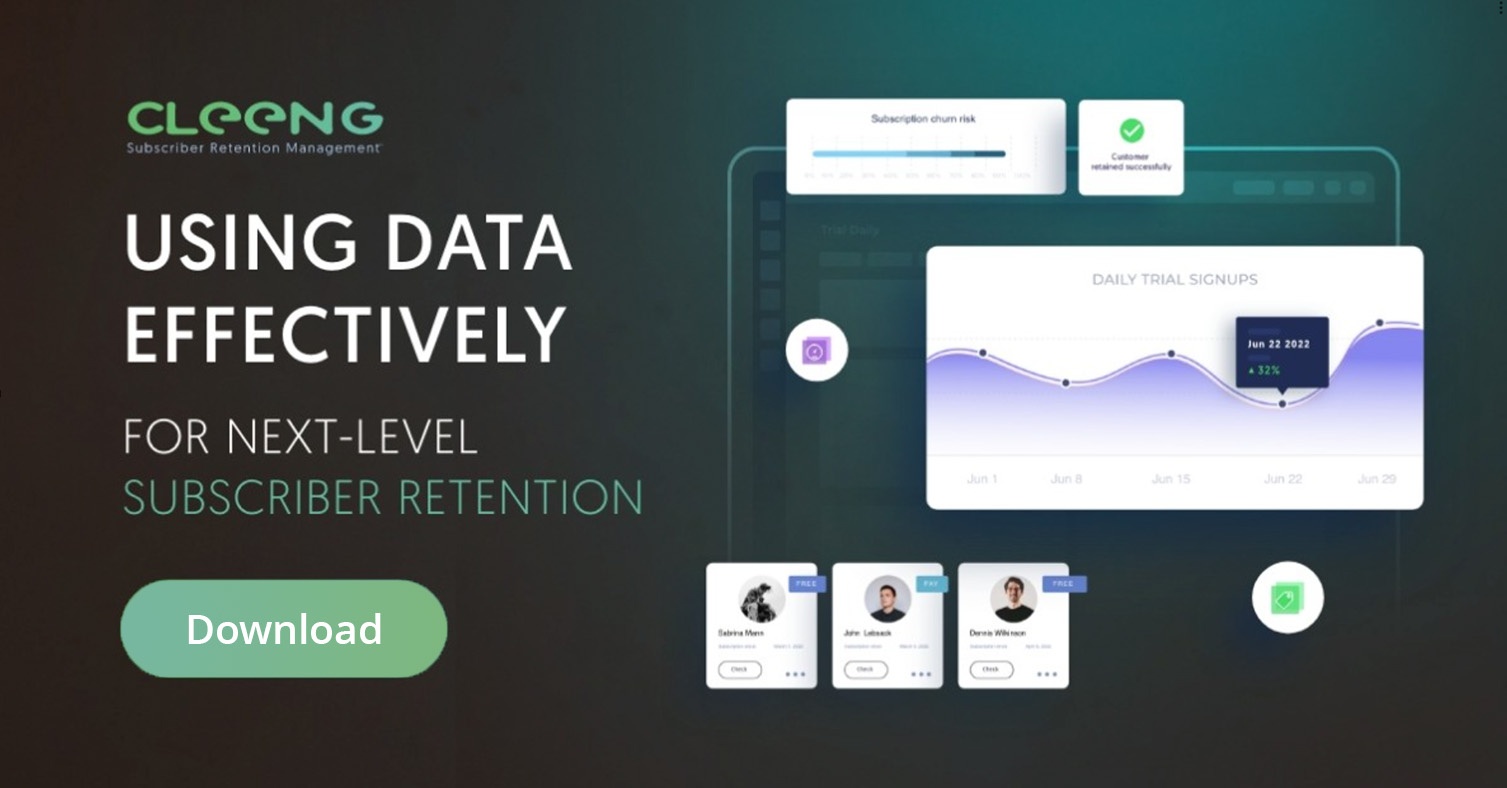
Customer acquisition is often perceived as the main path to growth, and that’s a big mistake. Sustainable growth can only come from nailing subscriber churn management and customer lifetime value (CLV).
In this blog post, you’ll find expert advice to grow your customer base and monthly recurring revenue (MRR) by improving customer satisfaction and reducing churn.
Subscriber churn in the OTT (Over-The-Top) industry has never been as high as now. From about 28% in 2015, subscriber churn reached an all-time high of 47% in 2023. This means that 47 % of SVOD users have canceled or will cancel a service at some point in 2023.
It raises crucial questions for OTT teams:
- How does it affect subscriber lifetime value?
- Can OTT services reverse the trend?
- If so, how?
Let’s dive in.
What is OTT subscriber churn?
And how should you go about measuring churn?
OTT subscriber churn refers to customers terminating their contract with a streaming or broadcasting service during a specific time period.
If churned customers are always a loss in revenue for broadcasters, we can split OTT churn into two categories.
- Voluntary churn refers to users canceling their subscriptions on purpose. It can result from a bad experience, a price increase, or if they got what they needed after binging a specific TV show or after a sports competition ended, for instance.
- Involuntary churn churn is often attributed to failed payments.
How to calculate customer retention rate (CRR)
You just need the following information to measure your customer retention.
- Number of customers at the start of a period (S);
- Number of new customers acquired during that period (N);
- Number of customers at the end of that period (E).
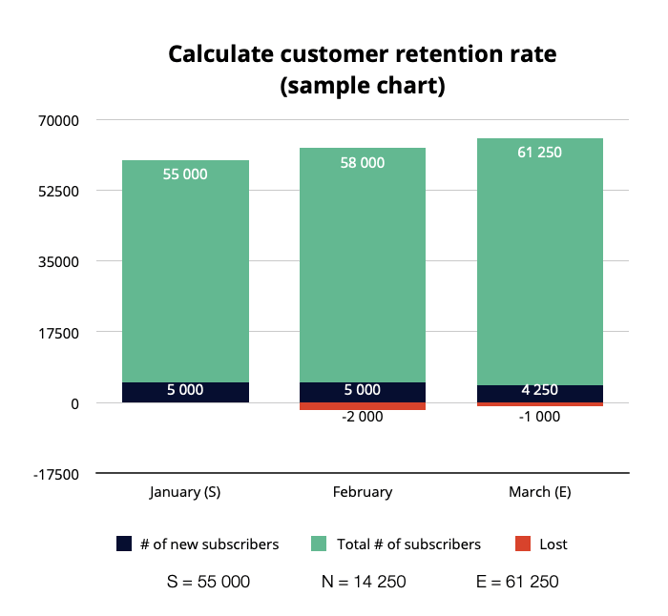
Here's the formula you should follow:
Customer retention rate = (( E - N ) / S ) * 100
In our scenario:
Customer retention rate = (( 61 250 - 14 250 ) / 55,500) * 100
Customer retention rate = 85.45%
—
In this made-up scenario, our retention rate is 85.45%.
How to calculate your churn rate
Here’s how to measure your customer (or subscriber) churn rate.
( Lost subscribers (L) / Number of customers at the start of a period (S)) * 100
If we continue from our previous scenario, we get the following:
Churn rate = (( 3 000 - 55 000)) * 100
Churn rate = 5,45%
—
In this made-up scenario, our churn rate is 5.45%.
What’s the difference between churn and customer retention rates?
It’s important to understand that churn and retention rates measure different indicators.
The churn rate tells you the percentage of lost customers during a specific time period.
On the other hand, the retention rate sees the glass half full and looks at the percentage of customers that stick around.
Good to know - Dollar retention rate (DRR)
Dollar retention is similar to viewer retention but focuses only on the revenue you retain (or revenue churn) rather than the viewers.
For instance, if your existing customers start paying more for their subscriptions through upgrades or additional purchases, your DRR might grow even if you lose viewers.
Good to know - Customer Retention Per Cohort
A cohort analysis is a great visual representation of your average customer lifecycle.
It allows you to separate users based on the start date and perform a detailed cohort analysis.

The cohort analysis adds another dimension to the performance of your SVOD service. It allows you to understand where and when to make changes to add value and encourage retention.
Essentially, you're looking for a flattening of the retention curve or that point in time in a cohort - whether it's day two or week three (or whichever time frame you choose) - where users cease churning.
What is customer lifetime value?
Customer lifetime value (CLV), or in this case, subscriber lifetime value (SLV), refers to the net profit that a company will generate from a customer throughout their entire subscription.
This is a useful metric as it helps paint a clear picture of the value your products or services drive.
To get to the most accurate number, we tend to use the following equation, where we take into account the Average Revenue Per Account (ARPA) and the churn rate:

Why is customer lifetime value a crucial indicator?
Customer retention is critical to the long-term success of your SVOD business.
Picture a bucket.
The more water you pour into a bucket, the more full it gets.
Now, if you pierce a couple of holes in the bucket, keeping the bucket full will require a constant heavy flow of water that’s at least as important as your loss.
The same thing applies to your subscribers.
If you can’t retain your subscribers, you’ll need to put much more effort (meaning time and money) into acquiring new customers. As a consequence, you may see your customer acquisition cost skyrocket.
This is why dealing with subscriber churn goes in pair with working on your subscriber lifetime value.
In other words, growth rhymes with customer loyalty for OTT services.
What’s the average Lifetime Value for SVOD subscribers
The folks over at Parks Associates revealed that the subscription duration for SVOD subscribers averages 40 months, ahead of vMVPD (virtual Multichannel Video Programming Distributor) services and far behind traditional Pay-TV services, currently yielding the most long-term subscribership.

This performance metric offers an accurate insight into the success of the engagement efforts and retention strategies surrounding your platform. By tracking your CLV regularly and analyzing relevant data to help make informed strategic decisions, you will catalyze your SVoD success.
How big of an issue is the current subscriber churn situation for SVOD services?
Evaluated at 47% in 2023, customer churn is becoming a real roadblock.
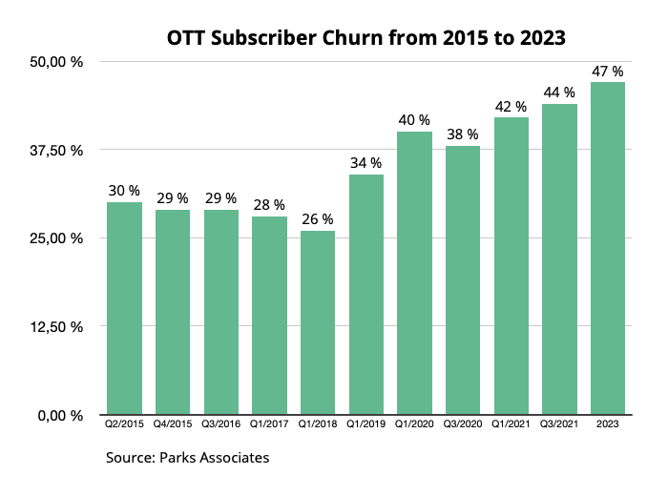
It’s interesting to note that subscriber churn rates have been increasing drastically since Q1 2019. Of course, the above numbers can look more alarming than they are if we don’t look at the whole picture.
In reality, the penetration of OTT video services in US households follows the same trend and has risen since 2018.
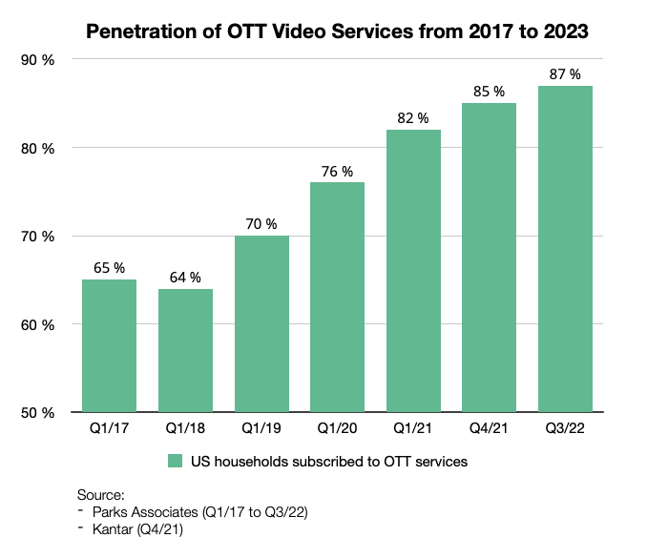
How can we explain this trend?
Simply put, we can attribute this to two major reasons:
- The COVID-19 pandemic (the elephant in the room): being clustered at home for so long had consumers turn to SVOD services to ease the overall experience.
- New services are emerging: the offer exceeds the demand. Consumers can now choose between leading platforms such as Netflix, ESPN+, Disney+, Amazon Prime Video, Crunchyroll, Hulu, HBO Max, or Paramount+, to name but a few, and there’s only so much time they can dedicate to entertainment during the day.
Moreover, studies from Parks Associates show that more than 40% of service cancelers used their OTT platform weekly or daily immediately before cancellation, showing that usage doesn't always dictate churn. And, among vMVPD (virtual Multichannel Video Programming Distributor) services, older providers have higher annual customer churn rates than newer services—which indicates that new players are learning from the mistakes of historical services.
Subscription Fatigue: a new root cause for OTT subscriber churn
Parks Associates also investigated why nearly one in two US subscribers have or will cut the cord with at least one subscription service this year.

In the current economic climate, it’s not surprising to see cutting household expenses as the #1 reason given for churning.
As more services try to enter our households, price becomes a critical factor. In fact, we also know that 54% of consumers aim at spending $50 - or less - on subscription services, thus putting a hard stop to market penetration.
In other words, value for money plays a key role.
Now, if you add this to the pre-existing choice paralysis induced by the incredible amount of options available for prospective subscribers, you get a perfect storm called Subscription Fatigue.
Having said that, what can OTT services do differently - or better than their competitors - to retain their subscribers and, by definition, increase their average subscriber lifetime value?
Valuable retention tactics to increase your subscriber lifetime value
Reducing customer churn is a real challenge for all subscription businesses. But with the right approach, you can set yourself apart from the pack.
Reduce involuntary churn
Easing your payment and renewal process is the best way to reduce involuntary churn.
For instance, ensure that your payment processing partners can notify subscribers ahead of renewal if their payment information needs to be updated.
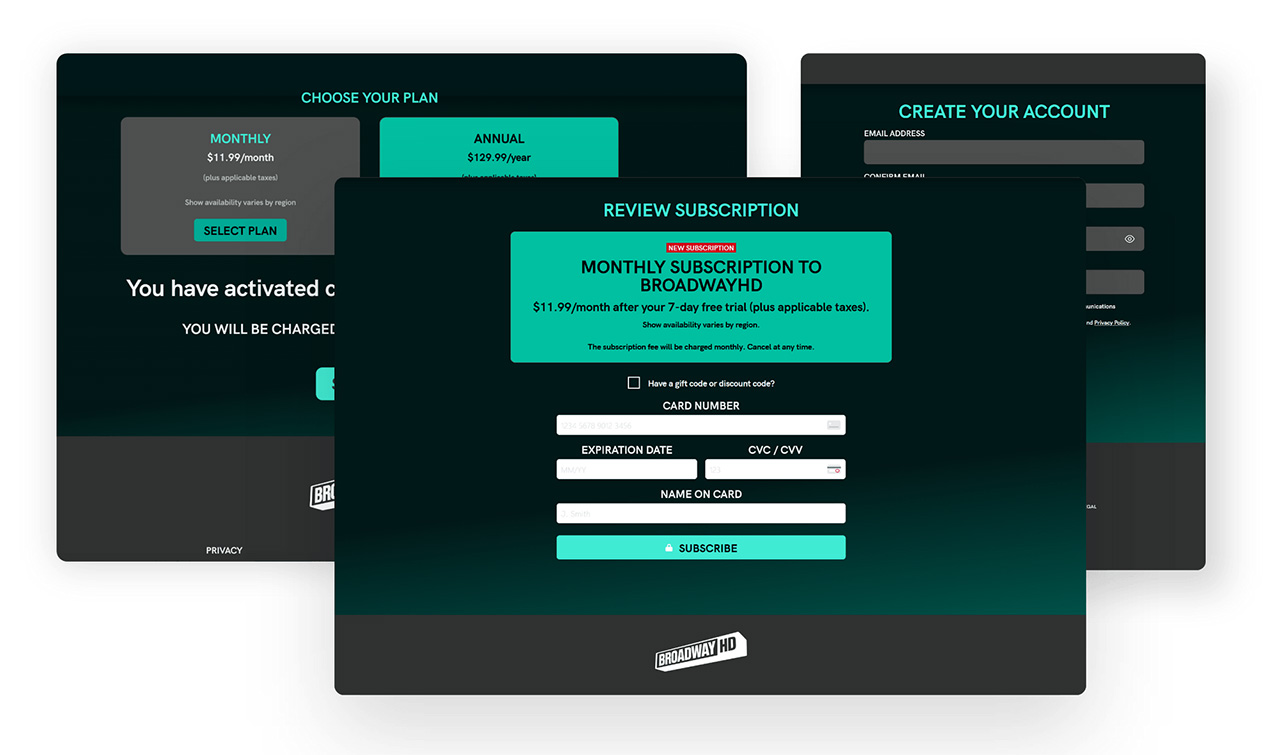
Since failed payments are one of the leading causes of involuntary churn, we’ve developed advanced payment analytics features to make billing and smooth checkout as painless as possible for you and your subscribers.
Learn more about our payment features.
Use AI-powered churn prediction to detect at-risk subscribers and trigger relevant events
Churn is essentially inevitable. But most types of churn are also predictable.
You will never be able to retain 100% of your customers. However, you can drastically reduce your OTT monthly churn rates by focusing on at-risk subscribers.
Your subscriber retention solution should let you identify and segment at-risk subscribers and let you set up and trigger specific events to:
- Grab their attention
- Score sympathy points and secure extended subscriptions.
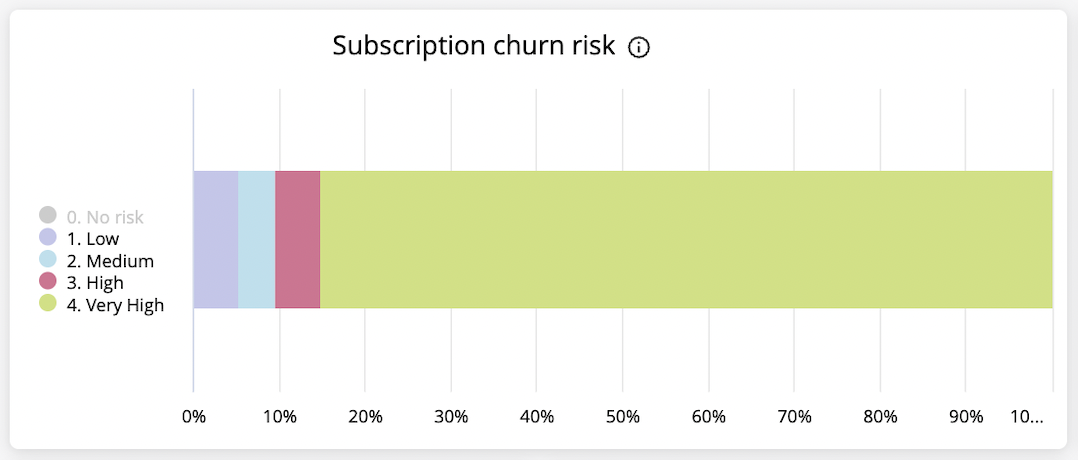
Behavior-based segmentation is an incredibly powerful churn-reducing approach.
Using behavioral data to your advantage, you can deliver tailored messages to subscribers through retargeting, native ads, bespoke pop-ups, push notifications, and well-placed alerts, sparking engagement and reducing churn rates while growing your audience.
Invest in premium customer service
Another good move towards reducing voluntary churn is quality and responsive customer service.
The harsh reality is that SVOD platforms may encounter technical glitches, buffering problems, or issues related to accessing content. Prompt and effective customer service will help customers troubleshoot these problems, ensuring they can enjoy uninterrupted streaming and maximize their satisfaction.
Read more about providing a unique support experience for your subscribers.
The ball is in your court.
The correlation between subscriber churn and CLV is undeniable.
If you focus your efforts on building a foolproof retention strategy to keep your subscribers happy and engaged with your content, you’ll likely see your lifetime value grow significantly.
—
Now, if you’d like to take the discussion further and discuss your customer retention challenges, our experts are just a few clicks away.

